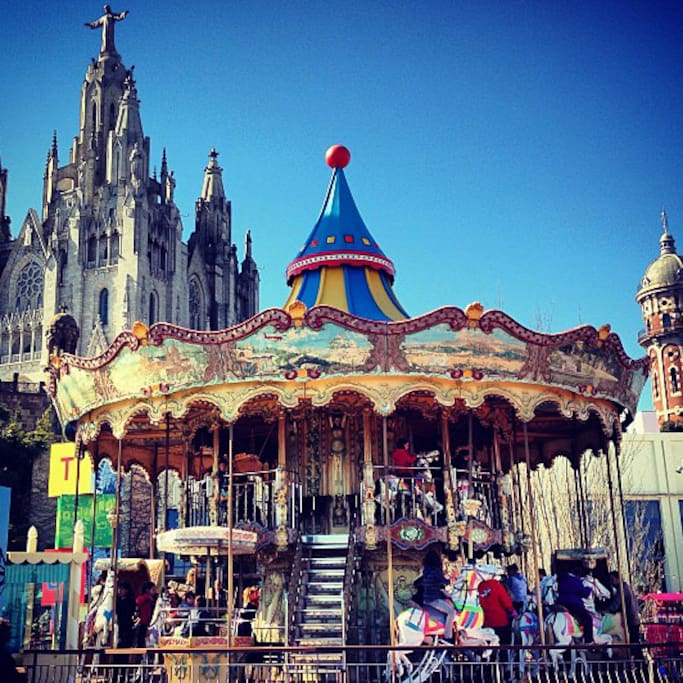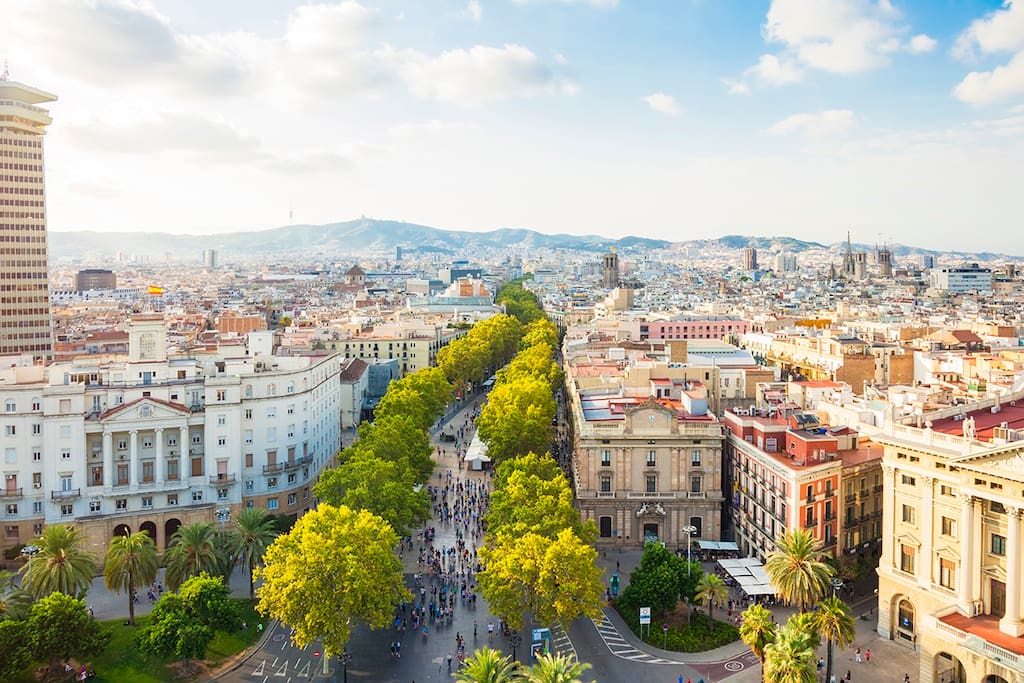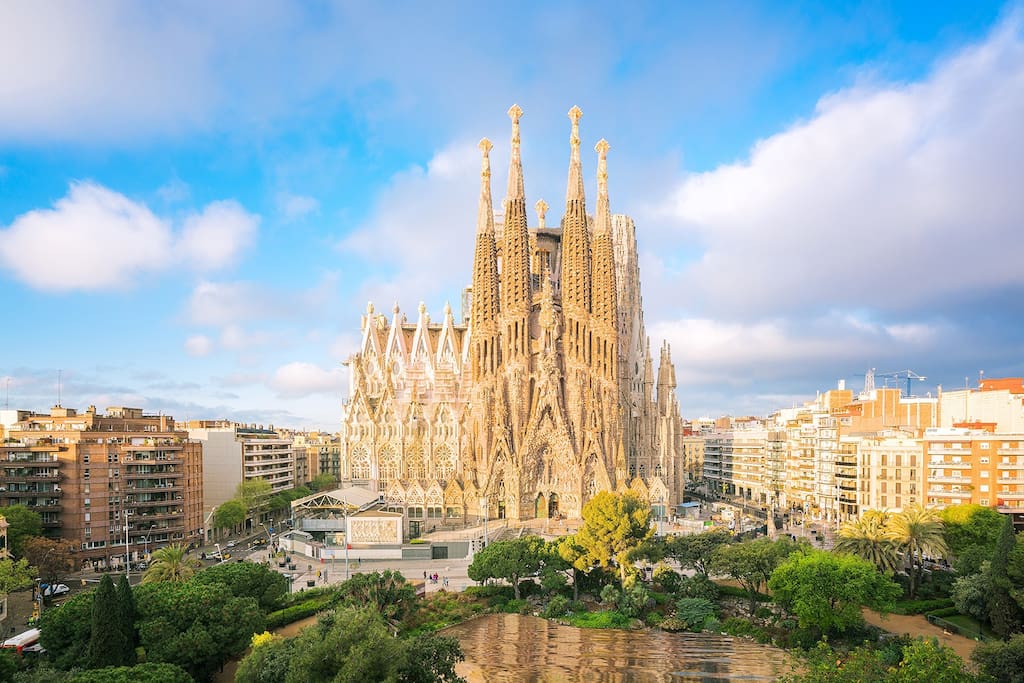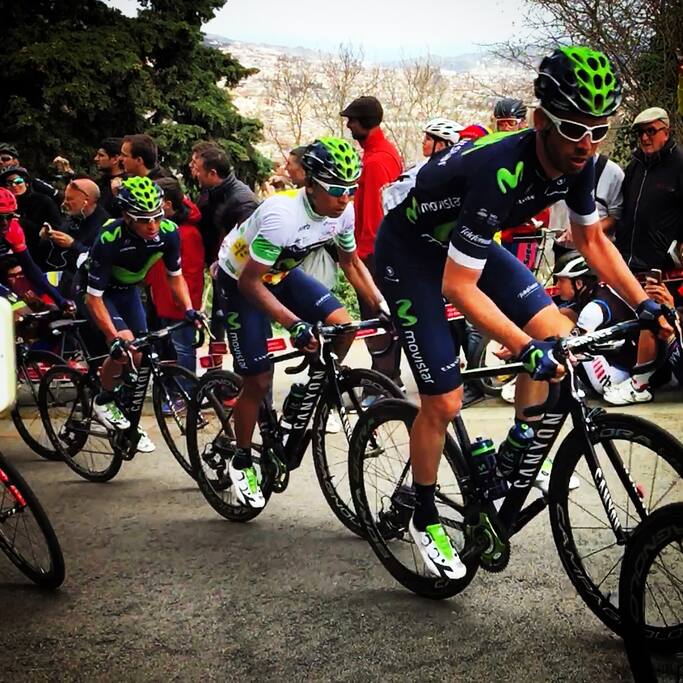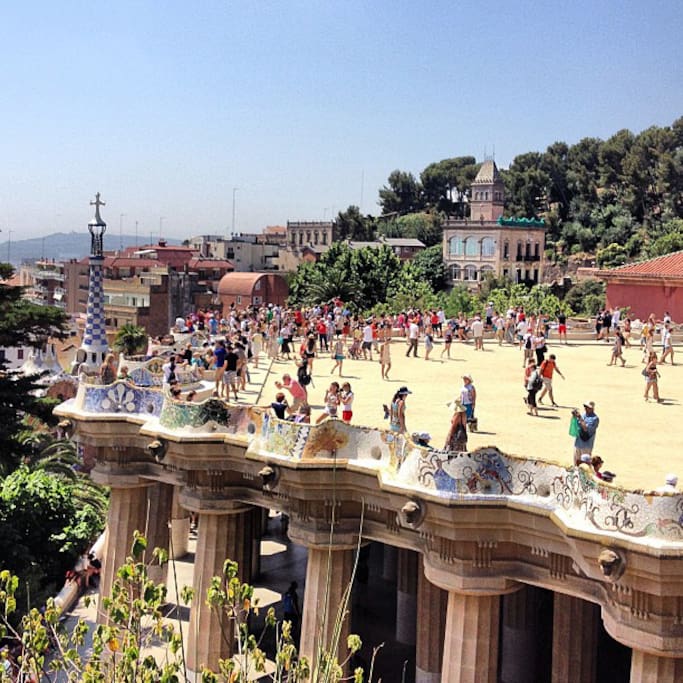Food Scene
Els Quatre Gats ( "The Four Cats" ), opened on 12 June 1897. It also operated as a hostel, a cabaret, a pub and a restaurant. Els Quatre Gats became one of the main centers of Modernisme in Barcelona.
231 locals recommend
Els 4Gats
3 Carrer de MontsióEls Quatre Gats ( "The Four Cats" ), opened on 12 June 1897. It also operated as a hostel, a cabaret, a pub and a restaurant. Els Quatre Gats became one of the main centers of Modernisme in Barcelona.
Comfortable family restaurant where you can eat well abundantly at a reasonable price.
38 locals recommend
Tasca i Vins
118 Carrer de la IndústriaComfortable family restaurant where you can eat well abundantly at a reasonable price.
Tasca i Vins
118 Carrer de la IndústriaClose to home.
Restaurant Los Bellota
298 Carrer de la MarinaClose to home.
About two thirds of the way up the Ramblas, on the left, you will see one of Europe's largest and most famous food markets. This is a place where I love to spend an hour or so feasting the senses. The Boqueria's grand iron entrance leads to a fully functioning world of food that throngs with both tourists and locals. The floors are slippy with melted ice and fruit skins and the stall holders are loud, but this all adds to the charm of the experience. You will find foods of all varieties and nationalities under one roof. The most famous of these bars is El Pinotxo, just to the right of the entrance.
1313 locals recommend
Mercat de la Boqueria
91 La RamblaAbout two thirds of the way up the Ramblas, on the left, you will see one of Europe's largest and most famous food markets. This is a place where I love to spend an hour or so feasting the senses. The Boqueria's grand iron entrance leads to a fully functioning world of food that throngs with both tourists and locals. The floors are slippy with melted ice and fruit skins and the stall holders are loud, but this all adds to the charm of the experience. You will find foods of all varieties and nationalities under one roof. The most famous of these bars is El Pinotxo, just to the right of the entrance.
The city now has four flourishing Taller de Tapas locations, all of them in beautiful street or squares, each serving fresh, simple Spanish food of the highest standard.
17 locals recommend
Taller de Tapas - Argenteria (Born)
51 Carrer de l'ArgenteriaThe city now has four flourishing Taller de Tapas locations, all of them in beautiful street or squares, each serving fresh, simple Spanish food of the highest standard.
Shopping
Lidl
Cheap German supermarket, from 9:30 at 21.15.
Sunday closed.
The most popular shopping center, with all brands of clothes, perfumes, shoes, etc, etc,
13 locals recommend
Viajes El Corte Inglés
14 Pl. de CatalunyaThe most popular shopping center, with all brands of clothes, perfumes, shoes, etc, etc,
Everything Else
Plaça d'En Joanic
Plaça d'En JoanicMetro Joanic: L4, to beaches.
Sightseeing
The views of Barcelona are fantastic and there is a small and fun vintage amusement park at the top (open from March to September).
722 locals recommend
Tibidabo
The views of Barcelona are fantastic and there is a small and fun vintage amusement park at the top (open from March to September).
Barceloneta Beach
Beaches.
El Born (La Ribera) is a small village in the city. Fashionable but very authentic : violin makers, glass-makers and designers... El Born forms with the Barrio Gótico the old city of Barcelona. How to visit the district of El Born ? Music Palace - Palau de la Musica Mercat de Santa Caterina Santa Maria del Mar Church Picasso Museum El Passeig del Born
162 locals recommend
Born Cultural Centre
12 Plaça ComercialEl Born (La Ribera) is a small village in the city. Fashionable but very authentic : violin makers, glass-makers and designers... El Born forms with the Barrio Gótico the old city of Barcelona. How to visit the district of El Born ? Music Palace - Palau de la Musica Mercat de Santa Caterina Santa Maria del Mar Church Picasso Museum El Passeig del Born
The centre of the Roman city, today's Gothic Quarter, We find the City Hall and the seat of the Catalan Government, the Palau de la Generalitat, the Cathedral, the Plaça de Sant Jaume In the Gothic Quarter, the Plaça del Rei proudly showcases the architectural ensemble made up of the royal residences of the Catalan-Aragonese monarchs. Below the square, you can visit the impressive archaeological remains of Roman Barcino. Behind the Cathedral stands the beautiful Plaça de Sant Felip Neri, with its baroque church.
526 locals recommend
Gothic quarter
Ronda de Sant PereThe centre of the Roman city, today's Gothic Quarter, We find the City Hall and the seat of the Catalan Government, the Palau de la Generalitat, the Cathedral, the Plaça de Sant Jaume In the Gothic Quarter, the Plaça del Rei proudly showcases the architectural ensemble made up of the royal residences of the Catalan-Aragonese monarchs. Below the square, you can visit the impressive archaeological remains of Roman Barcino. Behind the Cathedral stands the beautiful Plaça de Sant Felip Neri, with its baroque church.
La Rambla is another must-see. Starts at Plaza Catalunya and ends at the Monument of Columbus at the Port Vell harbour . Enjoy the human heartbeat of Barcelona.
1403 locals recommend
La Rambla
75 La RamblaLa Rambla is another must-see. Starts at Plaza Catalunya and ends at the Monument of Columbus at the Port Vell harbour . Enjoy the human heartbeat of Barcelona.
Temple Expiatori de la Sagrada Familia, The unfinished church. It is most significant symbol, and the most visited tourist attraction in Barcelona by Antoni Gaudi
3229 locals recommend
La Sagrada Cerveseria
16 Plaça Sagrada FamíliaTemple Expiatori de la Sagrada Familia, The unfinished church. It is most significant symbol, and the most visited tourist attraction in Barcelona by Antoni Gaudi
Montjuic Area: Font Mágica de Montjuïc. Today the Font Magica is still one of the most famous spots in Barcelona with an estimated 2.5 million visitors annually. Show of water, light and music..
478 locals recommend
Plaça d'Espanya
Montjuic Area: Font Mágica de Montjuïc. Today the Font Magica is still one of the most famous spots in Barcelona with an estimated 2.5 million visitors annually. Show of water, light and music..
Montjuïc Hill has borne witness to, and been the focus of key events that have shaped its personality. The first such event was the 1929 International Exhibition held in Barcelona which fostered the development of the zone. More recently, the 1992 Olympic Games brought about major renewal. Montjuïc is also home to museums, such as the Fundació Miró , the Museu d'Arqueologia, the Museu Etnològic and the Museu Nacional d'Art de Catalunya-MNAC. The latter, which is housed in the Palau Nacional, the centrepiece of the 1929 exhibition, invites us to discover 1,000 years of Catalan art. The Pavelló Mies van der Rohe, which was the German pavilion at the event, is a superb example of Bauhaus architecture. The former Casaramona textile factory, a modernista landmark by Puig i Cadafalch, is now home to CaixaForum, a cultural centre which hosts temporary exhibitions. The Magic Fountain and the Poble Espanyol, with its "artisans' village", are other places of interest in Barcelona which are a must-see. The Olympic Ring, the main site of the Olympic Games, features the stadium, the Estadi Lluís Companys, Arata Izosaki's sports palace, the Palau Sant Jordi, and the telecommunications tower designed by Santiago Calatrava. Nearby, the Museu Olímpic i de l'Esport Joan Antoni Samaranch and the Botanical Gardens are also unmissable sights as you explore the Parc de Montjuïc.
Editar
Estadio
1300 locals recommend
Montjuïc
Montjuïc Hill has borne witness to, and been the focus of key events that have shaped its personality. The first such event was the 1929 International Exhibition held in Barcelona which fostered the development of the zone. More recently, the 1992 Olympic Games brought about major renewal. Montjuïc is also home to museums, such as the Fundació Miró , the Museu d'Arqueologia, the Museu Etnològic and the Museu Nacional d'Art de Catalunya-MNAC. The latter, which is housed in the Palau Nacional, the centrepiece of the 1929 exhibition, invites us to discover 1,000 years of Catalan art. The Pavelló Mies van der Rohe, which was the German pavilion at the event, is a superb example of Bauhaus architecture. The former Casaramona textile factory, a modernista landmark by Puig i Cadafalch, is now home to CaixaForum, a cultural centre which hosts temporary exhibitions. The Magic Fountain and the Poble Espanyol, with its "artisans' village", are other places of interest in Barcelona which are a must-see. The Olympic Ring, the main site of the Olympic Games, features the stadium, the Estadi Lluís Companys, Arata Izosaki's sports palace, the Palau Sant Jordi, and the telecommunications tower designed by Santiago Calatrava. Nearby, the Museu Olímpic i de l'Esport Joan Antoni Samaranch and the Botanical Gardens are also unmissable sights as you explore the Parc de Montjuïc.
Editar
Estadio
Drinks & Nightlife
One of the best places in the city to try the more tasty tapas. You can find all kind of tapas and "montaditos" (peace of bread with something on top). 236, Mallorca Street
504 locals recommend
Cervesería Catalana
236 C. de MallorcaOne of the best places in the city to try the more tasty tapas. You can find all kind of tapas and "montaditos" (peace of bread with something on top). 236, Mallorca Street
Parks & Nature
Designed by Antoni Gaudi and now a UNESCO Worid Heritage Site, a The original plan for Parc Guell was to build a private and exclusive residential garden city with 60 houses on the grounds.
2138 locals recommend
Park Güell
Designed by Antoni Gaudi and now a UNESCO Worid Heritage Site, a The original plan for Parc Guell was to build a private and exclusive residential garden city with 60 houses on the grounds.
Arts & Culture
The museum is housed in several magnificent gothic mansions in the old medieval part of Barcelona called El Born.
1655 locals recommend
Museu Picasso
15-23 Carrer de MontcadaThe museum is housed in several magnificent gothic mansions in the old medieval part of Barcelona called El Born.
Modernist buildings: "Casa Mila" and nicknamed "La Pedrera" (the Quarry) designed by Gaudi. Also,"Casa Batlló" by Gaudi, "Casa Lleó-Morera", "Casa Amatller", "Palau Guell " in Raval.
1825 locals recommend
Casa Milà
92 Pg. de GràciaModernist buildings: "Casa Mila" and nicknamed "La Pedrera" (the Quarry) designed by Gaudi. Also,"Casa Batlló" by Gaudi, "Casa Lleó-Morera", "Casa Amatller", "Palau Guell " in Raval.
Casa Batlló is one of the two great buildings designed by Antoni Gaudí on Passeig de Gràcia, the other being La Pedrera. From the outside the façade of Casa Batlló looks like it has been made from skulls and bones. The "Skulls" are in fact balconies and the "bones" are supporting pillars. Gaudí used colours and shapes found in marine life as inspiration for his creativity in this building e.g. the colours chosen for the façade are those found in natural coral. Gaudí Casa Batlló at night It's worth taking a visit to see Gaudí's Casa Batlló at night, when it is illuminated
1846 locals recommend
CASA BATLLÓ
43 Pg. de GràciaCasa Batlló is one of the two great buildings designed by Antoni Gaudí on Passeig de Gràcia, the other being La Pedrera. From the outside the façade of Casa Batlló looks like it has been made from skulls and bones. The "Skulls" are in fact balconies and the "bones" are supporting pillars. Gaudí used colours and shapes found in marine life as inspiration for his creativity in this building e.g. the colours chosen for the façade are those found in natural coral. Gaudí Casa Batlló at night It's worth taking a visit to see Gaudí's Casa Batlló at night, when it is illuminated


